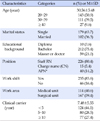Abstract
Purpose
This study was a cross-sectional study done to determine the relevance and impact factors of nursing practice environment and self-esteem on critical thinking disposition in clinical nurses.
Methods
A survey was conducted from March to May 2015 with self-report questionnaire. Participants were 281 registered nurses working in one tertiary hospital. Data were analyzed using descriptive statistics, t-test, ANOVA, Pearson correlation, and multiple regression with SPSS/WIN 21.0.
Results
Factors affecting the nurses' critical thinking disposition included age (F=7.23, p<.001), educational background (F=7.82, p<.001), position (F=14.95, p<.001), clinical career (F=7.66, p<.001). Further, critical thinking disposition had a positive correlation with nursing practice environment (r=.60, p<.001) and self-esteem (r=.41, p<.001). Self-esteem and nursing practice environment accounted for 43% of the variance in critical thinking disposition.
Conclusion
The study findings show that critical thinking disposition is influenced by nursing foundations for quality of care and the collegial nurse-physician relations of nursing practice environment. Therefore, it's necessary to provide continuing education for clinical nurses to reconstruct the organizational culture of nurses and physician partnerships. In addition, increasing self-esteem through various motivational programs should increase critical thinking disposition.
Figures and Tables
Table 2
Mean Scores for Nursing Practice Environment, Self-esteem and Critical-thinking Disposition (N=281)

Table 3
Differences in Nursing Practice Environment, Self-esteem and Critical-thinking Disposition according to General Characteristics (N=281)

References
1. Alfaro-LeFevre R. Critical thinking, clinical reasoning, and clinical judgment: a practical approach. 5th ed. St. Louis, MO: Saunders/Elsevier;2013.
2. Sung KS. Education for critical thinking. J Educ Idea. 2010; 24(3):155–172.
3. Zuriguel Pérez E, Lluch Canut MT, Falco Pegueroles A, Puig Llobet M, Moreno Arroyo C, Roldan Merino J. Critical thinking in nursing: Scoping review of the literature. Int J Nurs Pract. 2015; 21(6):820–830. DOI: 10.1111/ijn.12347.
4. Lunney M. Critical thinking to achieve positive health outcomes: nursing case studies and analyses. 2nd ed. New York, NY: John Wiley & Sons;2013.
5. Gang M. Critical thinking disposition and self-esteem of psychiatric mental health nurses. J Korean Acad Psychiatr Ment Health Nurs. 2011; 20(4):404–413. DOI: 10.12934/jkpmhn.2011.20.4.404.
6. Park S, Kwon IG. Factors influencing nurses' clinical decision making - focusing on critical thinking disposition. J Korean Acad Nurs. 2007; 37(6):863–871.
7. Jung SC, Jung DY. Relationship between critical thinking disposition, clinical decision making and job satisfaction of cancer center nurses. J Korean Acad Nurs Adm. 2011; 17(4):443–450. DOI: 10.11111/jkana.2011.17.4.443.
8. Park JA, Kim BJ. Critical thinking disposition and clinical competence in general hospital nurses. J Korean Acad Nurs. 2009; 39(6):840–850. DOI: 10.4040/jkan.2009.39.6.840.
9. Shoulders B, Follett C, Eason J. Enhancing critical thinking in clinical practice: Implications for critical and acute care nurses. Dimens Crit Care Nurs. 2014; 33(4):207–214. DOI: 10.1097/dcc.0000000000000053.
10. Lee JY, Pak SY. Relationship between the practice environment of nursing and critical thinking disposition of nurses in local general hospitals. J Korean Acad Nurs Adm. 2014; 20(2):145–153. DOI: 10.11111/jkana.2014.20.2.145.
11. Lake ET, Friese CR. Variations in nursing practice environments: relation to staffing and hospital characteristics. Nurs Res. 2006; 55(1):1–9. DOI: 10.1097/00006199-200601000-00001.
12. Cornell P, Riordan M, Townsend-Gervis M, Mobley R. Barriers to critical thinking: workflow interruptions and task switching among nurses. J Nurs Adm. 2011; 41(10):407–414. DOI: 10.1097/NNA.0b013e31822edd42.
13. Raterink G. Critical thinking: reported enhancers and barriers by nurses in long-term care: implications for staff development. J Nurses Staff Dev. 2011; 27(3):136–142. DOI: 10.1097/NND.0b013e318217b3f3.
14. Rosenberg M. Society and the adolescent self-image. Princeton, N.J.: Princeton University Press;1965.
15. Olthuis G, Leget C, Dekkers W. Why hospice nurses need high self-esteem. Nurs Ethics. 2007; 14(1):62–71. DOI: 10.1177/0969733007071359.
16. Profetto-McGrath J, Hesketh KL, Lang S, Estabrooks CA. A study of critical thinking and research utilization among nurses. West J Nurs Res. 2003; 25(3):322–337. DOI: 10.1177/0193945902250421.
17. Suliman WA, Halabi J. Critical thinking, self-esteem, and state anxiety of nursing students. Nurse Educ Today. 2007; 27(2):162–168. DOI: 10.1016/j.nedt.2006.04.008.
18. Chan ZC. A systematic review of critical thinking in nursing education. Nurse Educ Today. 2013; 33(3):236–240. DOI: 10.1016/j.nedt.2013.01.007.
19. Kang YS, Choi YJ, Park DL, Kim IJ. A study on nurses' self-leadership, self-esteem, and organizational effectiveness. J Korean Acad Nurs Adm. 2010; 16(2):143–151. DOI: 10.11111/jkana.2010.16.2.143.
20. Lake ET. Development of the practice environment scale of the Nursing Work Index. Res Nurs Health. 2002; 25(3):176–188. DOI: 10.1002/nur.10032.
21. Cho E, Choi M, Kim EY, Yoo IY, Lee NJ. Construct validity and reliability of the Korean version of the practice environment scale of nursing work index for Korean nurses. J Korean Acad Nurs. 2011; 41(3):325–332. DOI: 10.4040/jkan.2011.41.3.325.
22. Jon BJ. Self-esteem: a test of its measurability. Yonsei Nonchong. 1974; 11(1):107–130.
23. Berkow S, Virkstis K, Stewart J, Aronson S, Donohue M. Assessing individual frontline nurse critical thinking. J Nurs Adm. 2011; 41(4):168–171. DOI: 10.1097/NNA.0b013e3182118528.
24. Kwon JO, Kim EY. Impact of unit-level nurse practice environment on nurse turnover intention in the small and medium sized hospitals. J Korean Acad Nurs Adm. 2012; 18(4):414–423. DOI: 10.11111/jkana.2012.18.4.414.
25. Lee MH, Kim JK. A comparative study on nursing practice environment, professionalism, and job satisfaction according to hospital size. J Korean Acad Nurs Adm. 2013; 19(4):470–479. DOI: 10.11111/jkana.2013.19.4.470.
26. Ma C, Park SH. Hospital magnet status, unit work environment, and pressure ulcers. J Nurs Scholarsh. 2015; 47(6):565–573. DOI: 10.1111/jnu.12173.
27. Song HJ, Lee SM. The effects of hospital nurses' self-esteem and communication skill on self-leadership and the quality of nursing service. J Korean Acad Nurs Adm. 2016; 22(3):220–229. DOI: 10.11111/jkana.2016.22.3.220.
28. Choi H, Cho DS. Influence of nurses' performance with critical thinking and problem solving process. Korean J Women Health Nurs. 2011; 17(3):265–274. DOI: 10.4069/kjwhn.2011.17.3.265.
29. Benner P. From novice to expert: excellence and power in clinical nursing practice. London: Addison-Wesley;1984.
30. Boschma G, Einboden R, Groening M, Jackson C, MacPhee M, Marshall H, et al. Strengthening communication education in an undergraduate nursing curriculum. Int J Nurs Educ Scholarsh. 2010; 7(1):DOI: 10.2202/1548-923X.2043.




 PDF
PDF ePub
ePub Citation
Citation Print
Print





 XML Download
XML Download